Bayer R.G. Mechanical Wear Fundamentals and Testing, Revised and Expanded
Подождите немного. Документ загружается.

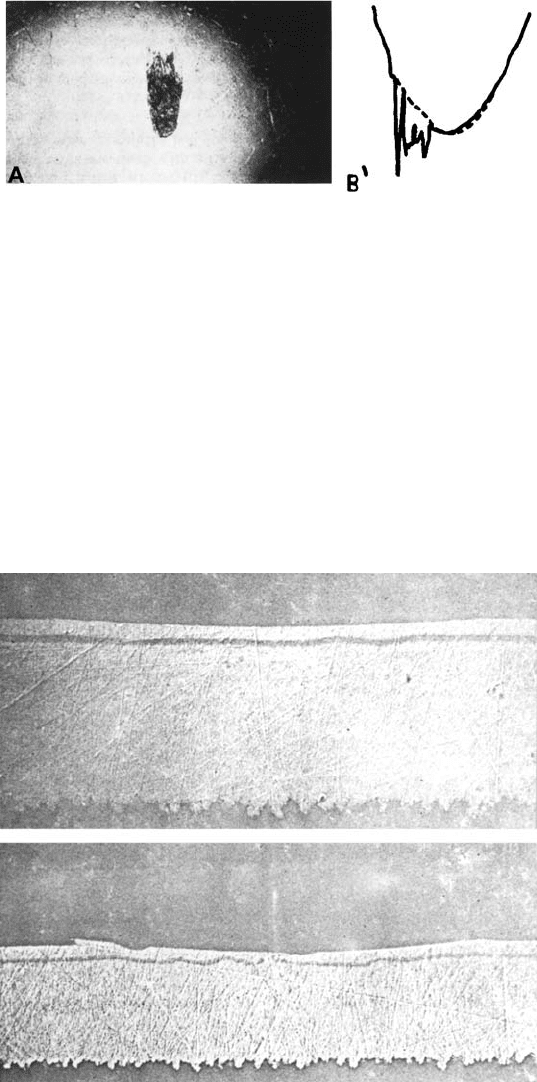
measure of wear volume. Another example would be in the case of the measurement of
wear of a coating. If there is no deformation of the substrate, the depth of the wear scar
can be directly related to the thinning of the coating. However, if deformation of the
substrate occurs, there may be no thinning of the coating but a depression or wear depth
can still be measured. The micrographs in Fig. 8.5
show the wear of printed c ircuit contact
tabs. In one, no noticeable wear of the Au plating has occurred, while there is a deep
wear scar, caused by deformation of the substrate. In the other, there is no deformation
of the substrate and the Au layer is severely worn. These two situations are extremely
different in terms of the corrosion protection and contact resistance that is provided by
Figure 8.4 ‘‘A’’ is a micrograph of sphere, showing mass gain in a sliding wear test. ‘‘B’’ is a
profilometer trace across the region, showing the build-up of material on the sphere.
Figure 8.5 Cross-section through the wear scar produced on Au plated printed circuit card tabs.
‘‘A’’ shows the situation when there is little or no substrate deformation involved; ‘‘B’’, when there
is significant deformation.
Copyright 2004 by Marcel Dekker, Inc. All Rights Reserved.
the Au layer. In this case, wear scar depth is not always a measure of the residual
thickness of the Au layer.
Consequently, it is a good practice to collect data regarding the general nature and
appearance of the wear scar produced in the test. This usually means observing and
recording information regarding the nature of the scar to supplement the primary mea-
surement. The most basic methods for this are: visual and low power optical micro-
scopy, followed by scanning electron microscopy (SEM), and higher power optical
microscopy. Some additional techniques that may be appropriate include electron dis-
persive x-ray analysis (EDX), Fourier Transform infra-red analysis (FTIR), electron
scanning for chemical analysis (ESCA), and Auger analysis (AUGER), as well as pro-
filometer measurements and cross-section examinations. In the extreme, it may be neces-
sary to routinely take SEM or optical micrographs of the wear scars, along with the
primary quantitati ve measurement. In cases where profilometer traces of the wear scars
do not provide the primary wear measure, consideration should be given to using them
as a means of providing additional information. In situations like the electrical contact
situation shown in Fig. 8.5, routine cross-sectioning on the scar might be needed or
desirable. These additional pieces of data have often proved to be very valuable and
in some cases essential in either improving control, modeling, or establishing correlation.
In sliding and rolling wear situations, it is generally desirable to measure or monitor
frictional behavior during the test. The correlation of frictional changes with wear
behavior frequently provides useful information regarding mechanisms and modeling.
This aspect will be treated further in a following section.
The minimu m information that should be recorded and associated with each wear
test is the values of the major parameters that influence the wear situation. These would
be those parameters, which are specifically controlled in the test. Beginning and ending
values of these parameters are desirable. It is also desirable to note and record information
regarding additional parameters and factors, which could influence the wear. Basically, a
fundamental set of auxiliary information that should be kept is information regarding spe-
cimen preparation, operational parameters of the test, and the environment surrounding
the test. When lubrication is involv ed, additional data and observations regarding the
lubricant and the method of supplying or application are also needed. Noti ng the state
of lubrication at the start, during, and end of the test is generally a good practice. Char-
acterization of the lubricant by Fourier Transform infra-red analysis and chromatography
techniques may be needed where degradation of the lubricant is a factor. Within a lab-
oratory, it is sometimes useful to note which engineer or technician conducted the test as
well. This might be of use in resolving problems associated with technique.
Several all-inclusive lists or forms for this purpose have been proposed (23,24), one
such form or list is shown in Fig. 8.6
. Examination of this form in Fig. 8.6 shows that the
listing is very extensive and identifies all the additional information and data referred to
in the preceding paragraphs. These lists include data and information regarding the nature
of the wear and wear scars for both members of a wearing interface. It is also recommen-
ded that such information be provided with the results reported in the literature. This ena-
bles the reader of such literature to assess the relevance of the published data to their
specific situations and can alert them to specific problems and sensitivities.
While it may not be practical or necessary to record all the information requested by
such a form, it is frequently desir able to review such a form when developing a wear test.
This helps to identify asp ects that should be controlled in the specific case or that should
be recorded to aid in the resolution of pot ential problems with the test or with correlation
to the field. Experience with the development and utilization of wear tests indicates
Copyright 2004 by Marcel Dekker, Inc. All Rights Reserved.
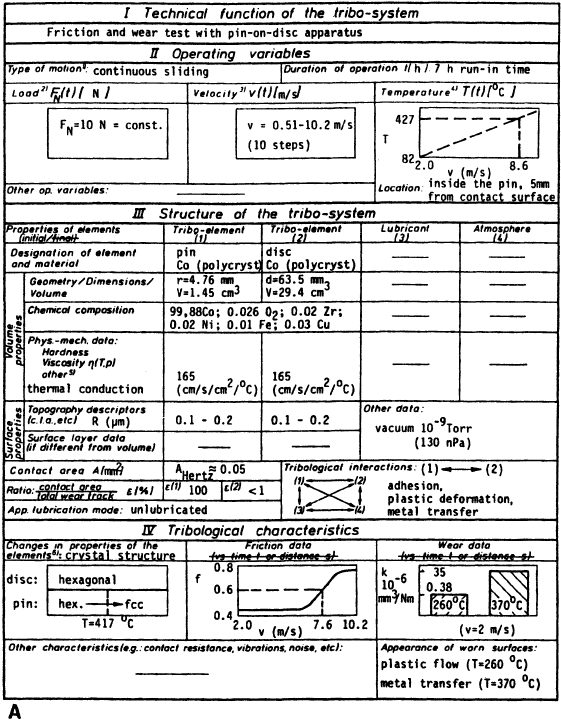
that what initially appears to be unnecessary attention to detail often turns out to be valu-
able information needed for the improvement of a test and establishing correlation. Once
a test is well-established, the amount of information that is needed can often be reduced
to the minimum set of major parameters or factors and attributes of wear scars.
One of the initial points made in this chapter was that it is frequently desirable to
generate wear curves in a test, rather than simply determine a single end-point value
(see Fig. 8.3). In the former, a curve of wear vs. amount of wearing action is developed
in the test. For example, this could be a curve relating depth of wear scar to number of
cycles, amount of time, or amount of abrasive used. In the latter, the wear is simply
measured after a specific amount of wearing action or exposure has taken place. There
are a few reasons for developing a wear curve. A fundamental one is that, in using a
single value, an underlying assumption is made that all the systems evaluated follow the
same relationship with duration or amount of wearing action. Consider a situation for
Figure 8.6 Examples of wear test data sheets. ‘‘A’’, pin-on-disc test; ‘‘B’’, ball-on-cylinder test.
(From Ref. 23, reprinted with permission from Elsevier Science Publishers.)
Copyright 2004 by Marcel Dekker, Inc. All Rights Reserved.
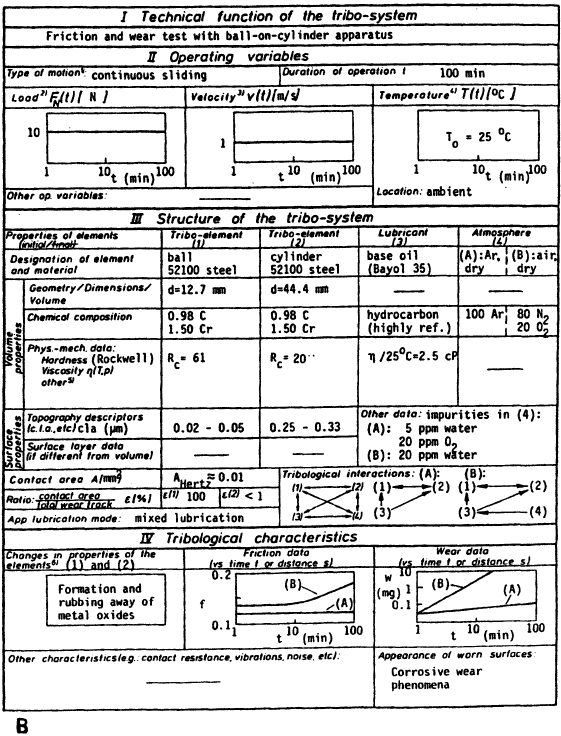
which the depth of wear, h, is relate d to the distance of sliding, S, by a relationship of the
following form:
h ¼ KS
n
ð8:1Þ
The use of a single value implies that the wear situation in the test is characterized by K.
This is valid if n is the same for all tribosystems involved in the evaluation. If n varies with
the system, which is often encountered in practice, a value for K no longer provides an
adequate characterization. In this case, both K and n are needed for complete character-
ization. The use of a single value approach in such a case can lead to errors, as illustrated
in Fig. 8.7
. This figure shows wear curves for two different materials obtained in the same
test. In this case, the wear curve is plotted on log–log paper. The linear behavior on the
log–log plot of these materials indicates that the be havior of both materials can be
described by Eq. (8.1) but with different values for n. As a result, it can be seen that if
an end-value of a short-term test is used to compare materials, material A would be
Figure 8.6 (continued )
Copyright 2004 by Marcel Dekker, Inc. All Rights Reserved.
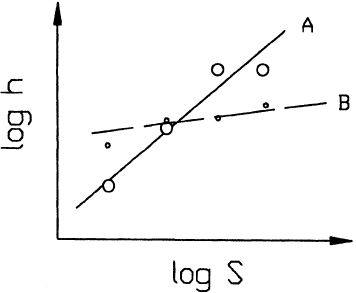
selected since it has less initial wear than material B. If, on the other hand, a longer test
time is used, material B would be selected. In this case, a value for both K and n is needed
to compare the behavior of these two materials.
The example shown is not an isolated case. There are many examples in the literature
which show wear curves intersecting, indicating that it is not appropriate to simply assume
that all systems will have all the same relationships, even in the same test (25–27). At the very
least, some testing should be done initially to demonstrate that such an assumption is valid.
If it is valid, then the test can be reduced to a single point; if not, a curve or multiple
point approach needs to be used to characterize a system. For a relationship of the type
shown, values of K and n as determined from the curve could be used to ch aracterize the
system.
Transitions in wear behavior as the amount of wearing action or test duration
increase can occur and is another reason for utilizing wear curves. Break-in and the intro-
duction of additional mode s of wear due to debris action are examples. In addition, there
can be incubation periods, such as can occur with fatigue wear, or there might be tw o
distinct modes of wear possible with one being more significant early in the test and other
becoming more significant in the longer term. An example of this behavior is the impact
wear of elastomers as shown in Fig. 8.8
(28). Initially, the impact wear of elastomers
is associated with a compression set (or creep type) behavior, which asymptotically
approaches a limiting value. After an incubation period, the elastomer begins to wear
by a fatigue process. A single measurement cannot provide adequate information about
such behavior and can often be misleading, as can be seen in this example. A short-term
test (e.g., less than 10
5
impacts) provides only comparison of materials in terms of their
initial creep behavior. It would, therefore, not be a good indicator for long-term pe rfor-
mance and in fact the wrong mate rial could be selected for an application which involves
a few million or more impacts. On the other hand, if simply an end-point value is obtained
in the long-term behavior region, the tendency would be to explain the wear behavior and
relative wear performance simply in terms of a fatigue mechanism. The result is at best
an incomplete, or more likely, an erroneous model or understanding. This would be a
problem in an application where the creep behavior is a significant contributor to the
dimensional change caused by the impact.
Figure 8.7 Hypothetical wear data for two materials in the same wear test, illustrating the
significance of wear curves in evaluations and the need for more than one parameter in charac-
terizing wear behavior.
Copyright 2004 by Marcel Dekker, Inc. All Rights Reserved.

Another reason for the use of wear curves in wear tests is associated with the more
sophisticated uses of such tests, that is, projecting field performance. Generally, a relation-
ship between time, cycles, distance, etc., and wear is needed. This relationship can be
established from a wear-curve approach but not from a single value. From these consi-
derations, it is evident that the use of wear curves in wear testing not only provides more
data and information about the wearing system but helps to avoid errors in wear testing.
Because of these aspects, wear curves should be used during the development of wear
tests. When a system or wear situation is sufficiently understood, then the reduction to a
single value may be appropriate. Also, if the relationship between wear and duration
is established, the wear measurements obtained at the individual data points used to
establish the wear curve can be normalized to provide additional values of the wear
coefficient. For example, in a case where the wear can be described by Eq. (8.1), the
depth of wear, h
I
, determined at different numbers of cycles or time, S
I
, can be divided
by S
n
i
to provide values of K.
Having addressed the merits and need for the development of wear curves in wear
testing, it is worthwhile to consider how such a curve can be developed. There are two
general ways of doing it. One is to interrupt the test at intervals for measurement and
characterization of the wear. The other is to use several different specimens or individual
tests, each being performed for different duration. Bot h approaches have been used
successfully. However, there is an inherent concern with the former. Since that method
involves interruption of the test, the wear situation could be altered. For example, beha-
vior of the type shown in Fig. 8.9
has been reported (29). This behavior suggests a break-
in type phenomenon occurring at each continuation point. Possible perturbations, which
can result in this type of behavior include: changes in alignment or positioning, oxide growth
or contamination of surfaces, and disturbance of wear debris. The sensitivity to these
elements or even relevance of these elements is not the same for all wear situations.
Consequently, provided proper care is taken, the perturbations can have a negligible effect
and the technique is acceptable in some cases. The second method, which utilizes several
specimens, eliminates this type of concern but in addition to requiring more specimens,
generally requires somewhat longer time. In addition, each data point obtained has
Figure 8.8 Impact wear behavior of elastomers, showing the effect of the presence of two wear
modes on the shape of the wear curve. In the initial region, a deformation mode predominates.
In the later stages, a surface fatigue mode predominates.
Copyright 2004 by Marcel Dekker, Inc. All Rights Reserved.
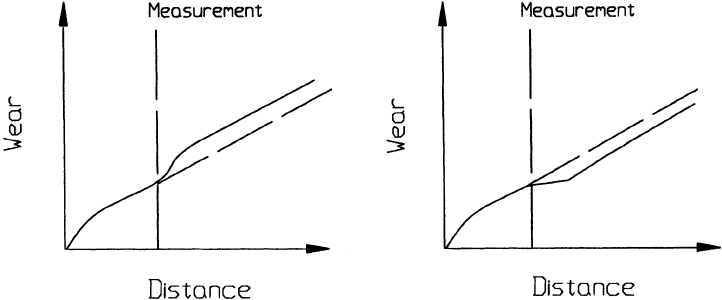
included its own scatter due to specimen variations. Therefore, specimen control is
extremely important in this approach since specimen-to-specimen variations can mask
other dependencies. An additional advantage of this approach is that worn samples from
each data point can be retained for more intensive analysis. With the single specimen
approach only samples from the end point are available for such type of analyses.
Because of this element, most testing programs shou ld involve some testing using the
multiple specimen approach so that detailed analysis of the state of wear in various
regions can be analyzed. This sort of analysis is generally required in addressing
simulation, acceleration, and correlation con cerns.
Another element with the de velopment of a wear curve is the selection of the inter-
vals for measurements. A good initial approach to use is to obtain data at an or der of
magnitude difference (e.g., 1, 10, 100 cycles), or on a logarithmic scale rather than on
a linear one. This provides a broad enough perspective that can be used to identify the
general dependency on duration, whi le minimizing concerns with measurement accuracy.
This approach is generally useful since for stabl e wear situations, the relationship between
wear and duration is at most linear and, if the measur e is other than volume, typically less
than linear. This means, for example, that doubling of duration typically does not result in
doubling the wear measure. In mild wear situations that are appropriate for many
engineering applications, the wear often has a very low dependency on durati on, such that
an order of magnitude increase in duration might only result in a 20–30% increase in the
wear measure (30,31). For this type of behavior, it is difficult to discern differences in wear
behavior over a small increment of duration.
These large increments also help to identify transitions and help in the development
of models and projections. Figure 4.46
is an example of a wear curve that shows a tran-
sition in wear behavior that is very significant for the application. In addition, it can be
seen that because of the relationship between wear and duration prior to the transition,
small increments of duration are not an appropriate way of gathering data in that region.
In the refinement of a test, smaller intervals can be used and may be desirable with
certain types of behavior. In the application associated with Fig. 4.46
, for example, finer
intervals near the transition region are appropriate since the value of this transition point
is quite significant.
Figure 8.9 Illustration of the possible effects of intermediate measurements and test interruptions
on wear behavior.
Copyright 2004 by Marcel Dekker, Inc. All Rights Reserved.
At each of the data points associated with the developm ent of a wear curve, the data
gathering should not be limited to the wear measure. The additional observations dis-
cussed at the beginning of this section should be done and it is desirable to record informa-
tion regarding operational parameters, environment conditions, etc., at these points. With
either approach, that is the single point or wear curve approaches, the investigator should
review all the data and observations, and look for consistencies or discrepancies between
the various observations. From these detailed examinations, one can develop information
regarding possible wear mechanisms and phenomena to aid in the formulation and selec-
tion of models. By coupling these types of observations with similar ones from actual
applications, simulation can be refined and verified. Suc h examinations also aid in the
establishment of adequate control. For example, alignment problems or the ap pearance
of different surface films or oxide layers could be identified. On the basis of these observa-
tions, the need for improvement in fixturing or environmental control could be assessed. In
performing these types of analyses, it is generally very helpful and informative to use sev-
eral levels of examination of the wear scars. Each level can provide a different perspective
about the wear situation. The use and coupling of visual examination of the wear scar, low
power stereo optical microscopy, metallographic microscopy, and SEM is frequently
desirable. Figure 8.10
shows an example of such a sequence. The visual and stereo micro-
scopic views provide information about the overall nature of the scars (e.g., shape,
gross features, debris formation, etc.).The higher levels of magnification associated with
metallographic microscopic and SEM examination provide information regarding the
microscopic details of the wear (e.g., transfer, cracks, etc.).
It is generally prudent not to rely on a single test; in wear testing, replicates are
generally necessary. Statistical design of experiments and statistical analysis can be used
to establish the proper number of replicates. However, as a rule of thumb, it is generally
desirable to use a minimum of 3. One is simply not sufficient.
If there is a big difference
in the results, it is difficult to differentiate between simply a poor result, or inherent scatter.
A third test can help to resolve that issue. More replicates might be required to provide
a good determination of the mean and standard deviation associated with the test.
However, for many engineering cases, estimates of these based on three tests are often
sufficient.
8.6. FRICTION MEASUREMENTS IN WEAR TESTING
In wear tests involving sliding or rolling, it is useful to incorporate friction measure-
ments, so that the coefficient of friction can be determined and to monitor tribosystem
behavior. There are several reasons for this. One is that in many engineering applications
tribological concern is not limited to wear. For example, in cases where traction, power
consumption, noise, and heat generation is of concern, knowledge of the coefficient of
friction and its behavior with wear is of direct interest and needs to be determined.
Another reason is that the coefficient of friction can be a factor in wear behavior. This
is the case with wear mechanisms that are sensitive to stress distribution and shear stres-
ses, since contact stress distributions and shear stresses can be modified by friction. The
maximum shear stress is a function of the contact pressure and the coefficient of friction
as well. For exampl e, the maximum shear stress of a flat on a flat is given by
t ¼ q
o
ð1 þ m
2
Þ
1=2
ð8:2Þ
Copyright 2004 by Marcel Dekker, Inc. All Rights Reserved.
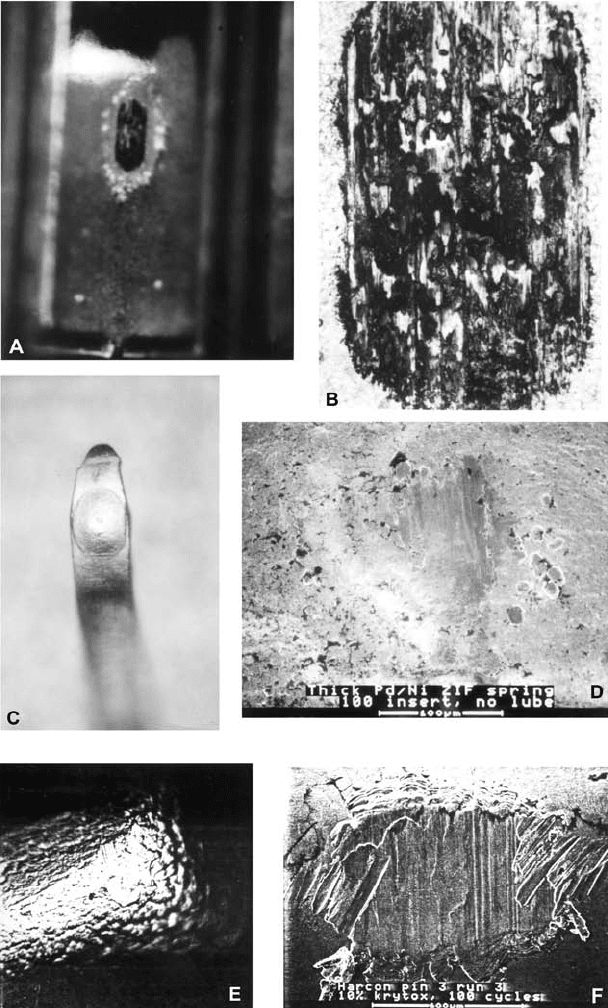
Figure 8.10 Example of the use of several examination techniques. ‘‘A’’, wear scar observed with a
stereo microscope and ‘‘B’’, the same wear scar observed in a metallographic microscope;
‘‘C’’, another wear scar observed with a stereo microscope and ‘‘D’’, the same wear scar in an
SEM; ‘‘G’’ and ‘‘H’’, another wear scar observed in an SEM, using two different detection modes.
Copyright 2004 by Marcel Dekker, Inc. All Rights Reserved.

where t is the maximum shear stress, q
o
, is the average pressure and m is the coefficient of
friction. Other contact situations have similar relationships (32). The location of maximum
shear stress and the distribution of shear stresses in a contact can also change with friction.
For example, for a point or line contact, the distribution changes with the coefficient
of friction. For coefficients less than 0.3 the maximum shear is below the surface. As
the coefficient increases the surface shear increases and above 0.3 exceeds the subsurface
shear stress (32). An additional reason for including friction measurements in a wear test
is that fric tion and wear are often sensitive to the same parameters. Changes in friction
are often associated with and are an indication of changes in wear-behavi or.
In summary, knowledge of the coefficient of friction and frictional behavior is gen-
erally needed for a complete approach to the wear. Beyond this as indicated previously,
friction measurements during the course of a wear test can often be of use in analyzing
wear behavior and insuring proper control in a wear test. This is because wear and friction,
while distinct, are sensitive to the same general range of parameters. Transitions in wear
behavior, which are associated with surface modifications, are frequently associated with
changes in friction. For example, in the case of unlubricated sliding between metals, the
Figure 8.10 (continued )
Copyright 2004 by Marcel Dekker, Inc. All Rights Reserved.
